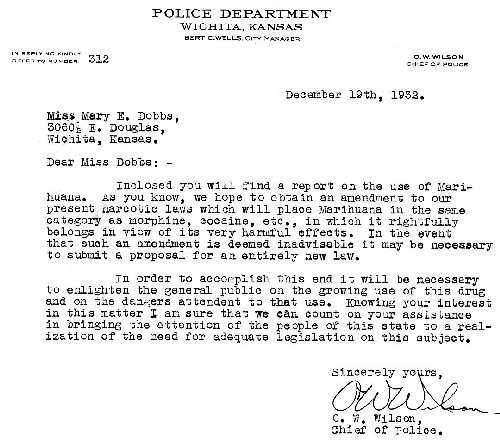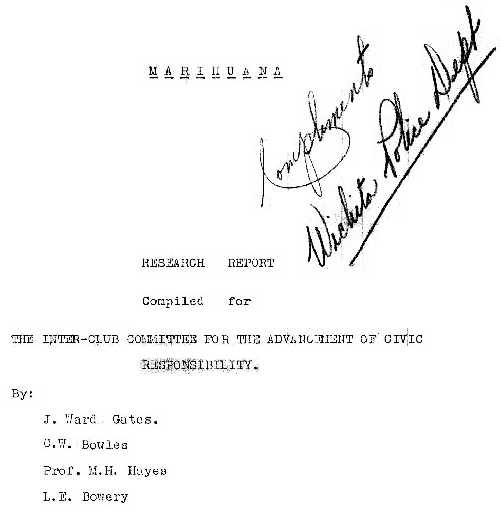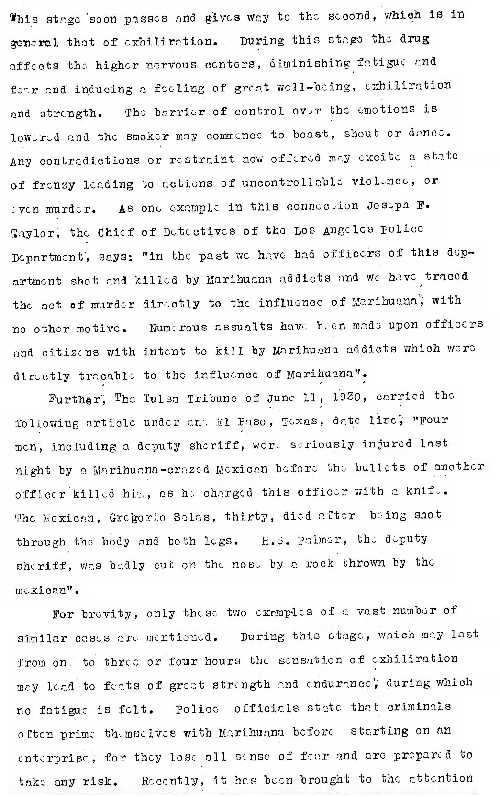
|
Chapter 4 - (2nd Edition) Kansas -- REEFER MADNESS |

|
|---|
DURING THE REEFER MADNESS ERA
Inside Detective Magazine - March 1961
MARIHUANA - A (Reefer Madness Era) RESEARCH REPORT:
The following is taken from a (semi-official) police report (Courtesy, Kansas State Library), parts of which were reprinted in various police and legal journals.




Below are selected parts that the reader might find of interest --- please remember that this report (written in Kansas), while laughable to us today, was reprinted over and over again in various Police and Criminal Journals. Thus having an influence in creating the Anti-Medical marihuana laws, Why? beyond the States boarders.
Cannabis Indica or Americana is one of the oldest known drugs. Back in the days of Omar Khayyam lived Hassanben-Sabah, the "Old Man of the Mountain", ruler, through the power of the drug, over thousands of fanatic brigands and murderers. His band was called the "Hashshasin", or hasheesh eaters. It was from this secret order of murderers that the word "assassin" came into being.Father please forgiven them for they know not what they do. -- Jesus (the son of God)
Effects
In general, the effects of Marihuana upon the smoker may be divided into three stages, of which the first and briefest is customarily a violent fit of coughing, which is due to the irritant effect of the smoke on the bronchial mucous membrane. This stage soon passes and gives way to the second, which is in general that of exhilaration. During this period the drug affects the higher nervous centers, diminishing fatigue and fear and inducing a feeling of great well-being, exhilaration and strength. The barrier of control over the emotions is lowered and the smoker may commence to boast, shout or dance. Any contradictions or restraint now offered may excite a state of frenzy leading to actions of uncontrollable violence, or even murder. As one example in this connection, Joseph F. Taylor, the Chief of Detectives of the Los Angeles Police Department, says: "In the past we have had officers of this department shot and killed by Marihuana addicts and have traced the act of murder directly to the influence of Marihuana, with no other motive. Numerous assaults have been made upon officers and citizens with intent to kill by Marihuana addicts which were directly traceable to the influence of Marihuana".
Further, The Tulsa Tribune of June 11, 1930, carried the following article under an El Paso, Texas, date line, "Four men, including a deputy sheriff, were seriously injured last night by a Marihuana-crazed Mexican before the bullets of another officer killed him, as he charged this officer with a knife. The Mexican, Gregorio Salas, thirty, died after being shot through the body and both legs. H. S. Palmer, the deputy sheriff, was badly cut on the nose by a rock thrown by the Mexican." [ Museum note: could not locate newspaper article under that date???]
For brevity, only these two examples of a vast number of similar cases are mentioned. During this stage, which may last from one to three or four hours, the sensation of exhilaration may lead to feats of great strength and endurance, during which no fatigue is felt. Police officials state that criminals often prime themselves with Marihuana before starting on an enterprise, for they lose all sense of fear and are prepared to take any risk. Recently, it has been brought to the attention of the police that members of dance-hall orchestras also use it as a stimulant. In some, this stage takes the form of hallucinations of sight and hearing; smokers will describe "beautiful sights or moving pictures, or trees, or people dancing or running, surrounded by beautiful colors". Others say that they hear musical voices or delightful sounds. The subjects of these hallucinations usually sit or decline dreamily smoking or meditative gazing into vacancy, while their sensations are pleasantly stimulated.
During this stage, sexual desires are stimulated and may lead to unnatural acts, such as indecent exposure and rape.
The gravity of the situation and the absolute necessity for action has been widely recognized by all intelligent individuals who have come into contact with the problem. The following are a few examples:
Former Governor Charles S. Whitman of the State of New York recently called the attention of the International Narcotic Educational Association to the growing menace of Marihuana. In a report, he pleaded for uniform state laws on the entire narcotic problem, and said, "Include the drug Cannabis Indica, Cannabis Sativa, or Cannabis Americana, among the prohibited drugs, under the same restrictions as cocaine. Its use is spreading through many of our large cities and in some sections of the country through smaller cities and communities as well. At first it gives a feeling of exaltation and physical power, but if continued it leads to insanity. Less than one-half of the states include this drug in their laws. It grows wild in the Southwest and its strength increases by cultivation."
Captain Richmond P. Hobson, member of the International Narcotic Commission, and a renowned Spanish-American War hero, states: "The drug can be grown anywhere and when smoked in small quantities produces a feeling of physical exhilaration. In excess, however, it motivates the most atrocious acts".
Dr. Oscar Bowling, President of the State Board of Health of Louisiana, following the difficulties resulting from the use of the drug in that state, published a warning to parents, guardians and teachers of children against this menace.
Mr. A. H. King, former Secretary of the Kansas State Board of Pharmacy, in reply to a letter, stated: "I believe it should be added to the list of narcotics in all narcotic laws. This would control the sale and use, and also the growth."
Mr. Joseph F. Taylor, Chief of Detectives of the Department of Police in the City of Los Angeles, states: "We have found from long experience and dealing with this type of criminal that Marihuana is probably the most dangerous of all our narcotic drugs. Our Los Angeles Police Narcotic Squad makes an average of about 50 arrests a month of peddlers and users of Marihuana".
Mr. Chas. H. Almond, Special Agent of one of our railroads, who deals with the Mexicans employed by his line, has spent twenty-two years in Mexico. He sponsored and lobbied for the present Marihuana law, and is an authority on that subject. He states that from his experience and observation of users of various narcotic drugs, it is his opinion that Marihuana constitutes the greatest menace of all He is alarmed at its rapidly spreading use by young white people, and is a strong advocate of the enactment of the laws providing penitentiary sentences for its sale and use. His observations are based on actual happenings within his territory, which extends from Chicago to the southern border of Oklahoma.
Guy C. Rexroad, Assistant Superintendent of the Kansas State Industrial Reformatory, at Hutchinson, Kansas, states that for some time past his institution has been experiencing a great deal of difficulty with Marihuana; that its presence within the walls was discovered entirely by accident, during an investigation of a theft of supplies which were being traded to Mexicans for the weed; that it constitutes a serious menace, and that he is strongly in favor of strengthening the laws to make its cultivation, possession, or sale a felony.
The Mayor of Boise, Idaho, is quoted as follows: "The Mexican beet-field workers have introduced a new problem-the smoking in cigarettes and pipes, of Marihuana or Grifo. Its use is as demoralizing as the use of other narcotics, and Idaho has no law to cope with the use and spread of this dangerous drug".
Officers have stated that youths are using Marihuana in place of liquor, due to its lower cost. There is obtainable a twenty-five cent package sufficient for about four cigarettes, which will produce a form of intoxication greater than that obtained from a pint of whiskey, which would cost from one dollar to one dollar and a half. A further reason for its use in preference to liquor is that it is easier to escape the detection of its use by parents, due to the absence of odor.
On August 24, 1929, the Kansas City Kansan carried a dispatch concerning the discovery by Wichita Police of the prevalence of Marihuana parties held by young boys and girls at roadhouses near this city. As long ago as November 12, 1928, the Kansas City Star disclosed its use in the Kansas City high schools, and in the University of Kansas. It is known to be rapidly spreading to the north among school children, as was forcibly brought out in an episode in Chicago on the 11th of June, 1932, when the Chicago Daily News reported police seizure of forty thousand cigarettes and one hundred and fifty pounds in bulk, with a total value of $4,000.00. This was intended for sale to children in the Austin, Hyde Park, and McKinley schools in that city, a profitable trade among these pupils having been worked up. In still another instance the Tulsa Tribune on September 10, 1929, [museum note: - the correct date is Sept. 11, 1929] describing the arrest of D. N. Niditis, a Mexican hot-tamale salesman, said that his home at 1019 E. Archer street, in that city, was a veritable dope den for young boys and girls of high school age, as well as others who have been known to go there to obtain the drugged cigarette.
The rapid spread of this habit among young people throughout the country and the inability of officers and courts to stamp it out under present inadequate laws, together with the damage both to the individual and to society resulting from its use, makes it imperative that some action be taken, and that expeditiously.
One witness testifying in this investigation cited a large number of typical examples of the effect of Marihuana of which the following is the outstanding case. A Mexican, under the influence, while going beneath a railroad viaduct imagined that he saw approaching him, at great speed, a rider on an enormous horse. Dodging behind a column for protection, when he looked out again, he realized that what he had seen was an old woman pulling a small wagon. Going home, despite the fact that his wife had that day given birth to a child, he compelled her to get out of bed and prepare his dinner. Still suffering from the characteristic hallucinations, as she was peeling an onion, he imagined that she was preparing to attack him, and seizing a club he hit her in the head with such force that she was knocked unconscious. While this is only one example, it is typical of conditions among habitual smokers.
WANT TO KNOW MORE:
=====================
Due to space / download time considerations, only selected materials are displayed. If you would like to obtain more information, feel free to contact the museum. All our material is available (at cost) on CD-Rom format.
CONTACT PAGE
 Previous |
 Main Page |